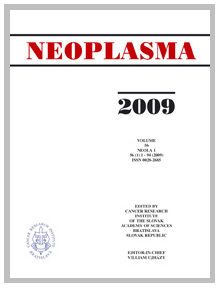Journal info
|
||
Select Journal
Journals
Bratislava Medical Journal Ekologia - Ecology Endocrine Regulations General Physiology and Biophysics Neoplasma 2025 Ahead of print 2024 2023 2022 2021 2020 2019 2018 2016 2017 2015 2014 2013 2012 2011 2010 2009 2008 2007 2006 2005 2004 2003 Acta Virologica Studia Psychologica Cardiology Letters Psychológia a patopsych. dieťaťa Kovove Materialy-Metallic Materials Slovenská hudba 2025Webshop Cart
Your Cart is currently empty.
Info: Your browser does not accept cookies. To put products into your cart and purchase them you need to enable cookies.
Neoplasma Vol.67, No.6, p.1329–1334, 2020 |
||
| Title: Targeted axillary dissection with preoperative tattooing of biopsied positive axillary lymph nodes in breast cancer | ||
| Author: J. GATEK, V. PETRU, P. KOSAC, M. RATAJSKY, J. DUBEN, B. DUDESEK, P. JANCIK, M. ZABOJNIKOVA, J. KATRUSAK, P. OPELOVA, L. PODRAZSKA, P. VAZAN, P. KUDLOVA, P. HOLIK, B. MELICHAR, D. VRANA | ||
| Abstract: Sentinel lymph node biopsy (SLNB) has emerged as an alternative to axillary lymph node dissection during breast cancer surgery during the last 2 decades. However, there are several controversies regarding the indication of the sentinel node biopsy after neoadjuvant chemotherapy which can convert positive lymph nodes to negative. The false negative rate after neoadjuvant chemotherapy is unacceptably high. This high false negative rate can be decreased by marking of the positive lymph nodes and removal during sentinel lymph node biopsy procedure in addition to the sentinel lymph nodes. The aim of this study was to investigate the possibility of carbon tattooing of the positive sentinel lymph nodes before neoadjuvant chemotherapy. In 2016, a prospective protocol was launched investigating the black carbon tattooing procedure of the suspective and positive axillary lymph nodes by injecting 0.1-0.5 carbon ink in normal saline under ultrasound guidance. All patients underwent black carbon tattooing of the suspected or positive axillary lymph nodes before the chemotherapy or one week before the primary surgery when chemotherapy was not indicated in the neoadjuvant setting. Sentinel lymph nodes together with lymph nodes marked by the black carbon ink were removed and histologically evaluated. So far 27 patients were treated under this protocol. Breast saving surgery was performed in 22 cases and mastectomy in 5 cases. All patients had invasive ductal carcinoma. In 20 patients neoadjuvant chemotherapy was indicated and in 7 patients primary surgery was performed. All lymph nodes marked by black carbon ink were successfully identified and removed. Sentinel lymph node biopsy was performed in 8 cases and sentinel lymph node biopsy followed by axillary dissection in 15 cases. Axillary dissection alone was performed in 4 cases. In 19 cases the black carbon ink was present in the sentinel lymph node at the same time and in 4 cases carbon dye was present in other lymph nodes than lymph node identified during SLNB, which corresponds to 17.4%. In the group of patients undergoing primary surgery, in one case from six, the sentinel lymph node was negative and the lymph node marked with carbon ink positive which represents false negative lymph node and failure of the SLNB procedure. After neoadjuvant chemotherapy, there was no false negative lymph node identified, but the conversion of the positive lymph nodes to negative was present in 10 cases (50%). There were no complications attributed to carbon ink tattooing. |
||
| Keywords: | ||
| Published online: 04-Aug-2020 | ||
| Year: 2020, Volume: 67, Issue: 6 | Page From: 1329, Page To: 1334 | |
| doi:10.4149/neo_2020_191228N1344 |
||
|
|
 download file download file |
|

